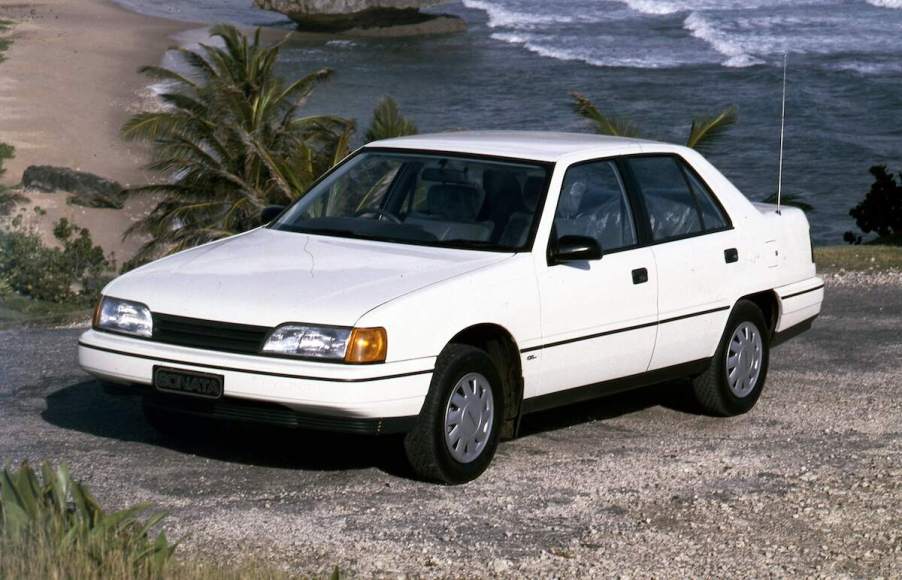
How 1 Cheap Hyundai Car Nearly Killed the Company in the ’80s
In the mid-1980s, Hyundai wanted a piece of the lucrative U.S. car market. The South Korean automaker was buoyed by the massive and unexpected success of the brand’s Pony in Canada. Styled by Giorgio Giugiaro, powered by Mitsubishi, and designed with the help of a few English engineers who defected from British Leyland, the Pony was the first car Hyundai designed by itself one decade earlier.
Because the somewhat utilitarian rear-wheel-drive Pony was aging and unable to meet American emissions standards, Hyundai decided on a new clean-sheet design for the U.S. market, one with front-wheel drive. The brand again called on Giugiaro — fresh from penning the BMW M1, DeLorean DMC-12, and Lotus Esprit — to design the coachwork. Underneath the new Hyundai Excel’s admittedly attractive skin, the underpinnings drew heavily on Mitsubishi’s second-generation Mirage.
The cheap Hyundai car was a blockbuster success

As it turns out, Hyundai’s timing was fortuitous. Americans’ interest in cheap cars was piqued by the ill-fated Yugo that had debuted a year earlier, combined with a voluntary limitation of Japanese imports at the request of the U.S. government to help protect domestic automakers. At a base price of $4,995 (about $14,000 in today’s money), the 1986 Hyundai Excel was $1,000 more than its bargain-basement competitor, the Yugo, but offered much more value.
The Excel was considerably more spacious, modern, and available in three body styles: a three-door hatchback, a five-door hatchback, and a four-door sedan. As anticipated, Americans scooped up the cheap Hyundai car like hotcakes. The Excel sold well over 100,000 units in its first year of production, a record for first-year sales of an imported vehicle. Still, some buyers remained skeptical about the overall quality of a car made in South Korea, not unlike how Americans might feel about buying cars imported from China nowadays.
Several high-profile Hyundai Excel recalls dinged the company

It didn’t take long for the naysayers to be proven correct — the cheap Hyundai car indeed had its share of quality-control issues. In March 1986, within months of delivering its first vehicles, Hyundai recalled every Excel. The connection between the brake pedal and master cylinder was found to have a damaged or nonexistent cotter pin, resulting in complete brake system failure, the Los Angeles Times reported.
A few years later, in 1991, the company again recalled every Excel — a number that had ballooned to almost 900,000 vehicles. This time, engine exhaust gases could melt the plastic air filter assembly, potentially starting a fire in the engine compartment.
Besides accumulating a reputation for unreliability, the Hyundai Excel was extremely underpowered, which might have contributed to an overall negative sentiment. In a 1986 road test, Car and Driver piloted one from 0 to 60 mph in an agonizing 16 seconds. The top speed was about 90 mph with a good tailwind.
Hyundai’s unprecedented warranty helped turn things around
By the time the second major recall happened in the early 1990s, Hyundai sales were beginning to dwindle. Japanese manufacturers had developed competing affordable cars while fueling the criticism against Hyundai to their advantage. By the decade’s end, the company realized it needed to right its public image or face U.S. extinction. So, it made a serious investment in research, quality, and manufacturing.
In a more direct appeal to buyers, Hyundai introduced a new warranty on its vehicles. Its unprecedented five-year/60,000-mile bumper-to-bumper warranty and 10-year/100,000-mile powertrain coverage were designed to instill confidence in the tarnished brand.
According to The New York Times, the company hatched a $25 million advertising campaign to spread the word about the brand’s newfound focus on quality and reliability. And it worked.
The company is nothing like its old self
Nowadays, Hyundai is virtually unrecognizable as the same company from its rocky start. Its crossover SUVs like the Tuscon, Sante Fe, and Palisade have serious cachet in the marketplace. So does its newly facelifted Elantra compact sedan, which represents the spirit of conventional passenger cars in an increasingly SUV-filled world. But if a truck is what you’re after, Hyundai also offers the compact Santa Cruz pickup, a Ford Maverick rival with a sub-$30,000 base price.
Besides producing a host of hybrid and plug-in hybrid electric vehicles, the brand is also making a serious splash in the all-electric vehicle space with no less than three EV models for 2024. There’s the boxy Ioniq 5 SUV; the sleek coupe-inspired Ioniq 6 sedan that starts under $50,000; and the plucky Kona subcompact crossover available as an all-electric variant.





